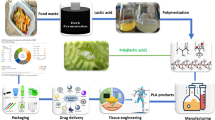Abstract
Synthesis of novel polyurethane copolymers containing covalently attached, well-oriented Arg-Gly-Asp (RGD) peptides was explored. A poly(tetramethylene oxide) based polyurethane was synthesized, and a bimolecular nucleophilic substitution reaction was then employed to incorporate ethyl carboxylate groups onto the polymer backbone. Cell-adhesive peptides Gly-Arg-Gly-Asp-Ser-Tyr (GRGDSY) and Gly-Arg-Gly-Asp-Val-Tyr (GRGDVY) were covalently bound to the polyurethane backbone via the formation of amide bonds. Nuclear magnetic resonance (NMR) and Fourier transform infrared (FTIR) spectroscopies were used to monitor the reactions. The amount of grafted peptide was determined by amino acid analysis. Electron spectroscopy for Chemical Analysis (ESCA) suggested the presence of the grafted peptide at the polymer-air interface in vacuo. Dynamic contact angle analysis showed that, in water, the peptide-grafted polyurethane surfaces were more polar than the underivatized polyurethane. The attachment and spreading of human umbilical vein endothelial cells (HUVECs) on the underivatized and peptide-grafted polyurethanes was investigated. The GRGDSY-and GRGDVY-grafted substrates supported cell adhesion and spreading even without serum in culture medium. The GRGDVY-grafted substrate supported a larger number of adherent cells and a higher extent of cell spreading than the GRGDSY-grafted substrate. These RGD-containing peptide grafted polyurethane copolymers may be useful in providing an easily prepared cell-adhesive substrate for various biomaterial applications.
Similar content being viewed by others
References
M.D. Lelah and S.L. Cooper., Polyurethanes in Medicine (CRC Press, Boca Raton, 1986), pp. 57–71.
M. Szycher, in Biocompatible Polymers, Metals, and Composites, edited by M. Szycher (Technomic, Lancaster, 1983), pp. 1–33.
M.B. Herring, A.L. Gardner and J. Glover, Surgery, 84, 498 (1978).
R.S. Dilley and M.B. Herring, in Biology of Endothelial Cells, edited by J.A. Jaffe (Martinus Nijhoff, Boston, 1984), pp 401–411.
N.K. Nichols, D. Cospodarwitz, T.R. Kessler and D.B. Oslen, Trans. Am. Soc. Artif. Intern. Organs, 27, 208 (1981).
E. Ruoslahti and M.D. Pierschbacher, Science, 238, 491 (1987).
L.R. Languino, S. Coella, A. Zenetti, A. Andrieux, J.J. Ryckewaert, M.H. Charon, P.C. Marchisio, E.F. Plow, M.H. Ginsberg, G. Marguerie and E. Dejana, Blood, 73, 734 (1989).
B.K. Brandley and R.L. Schnaar, Analytical Biochem., 172, 270 (1988).
S.P. Massia and J.A. Hubbell, J. Biomed. Mater. Res., 25, 223 (1991).
H.-B. Lin, Z.-C. Zhao, C. Garcia-Echeverria, D.H. Rich and S.L. Cooper, J. Biomater. Sci., Polymer Ed., in press (1991).
D.S. King, C.G. Fields and G.B. Fields, Int. J. Peptide Protein Res., 36, 255 (1990).
Acknowledgements
The authors wish to acknowledge Dr. Daniel H. Rich (Department of Medicinal Chemistry, University of Wisconsin-Madison) for helpful suggestions and kind collaboration. This work was supported by the National Institutes of Health through grants HL-24046 and HL-47179.
Author information
Authors and Affiliations
Rights and permissions
About this article
Cite this article
Lin, HB., Cooper, S.L. Polyurethane Copolymers Containing Covalently Attached RGD-Peptide: Synthesis and Cell Adhesion Studies. MRS Online Proceedings Library 252, 185–192 (1991). https://doi.org/10.1557/PROC-252-185
Published:
Issue Date:
DOI: https://doi.org/10.1557/PROC-252-185




